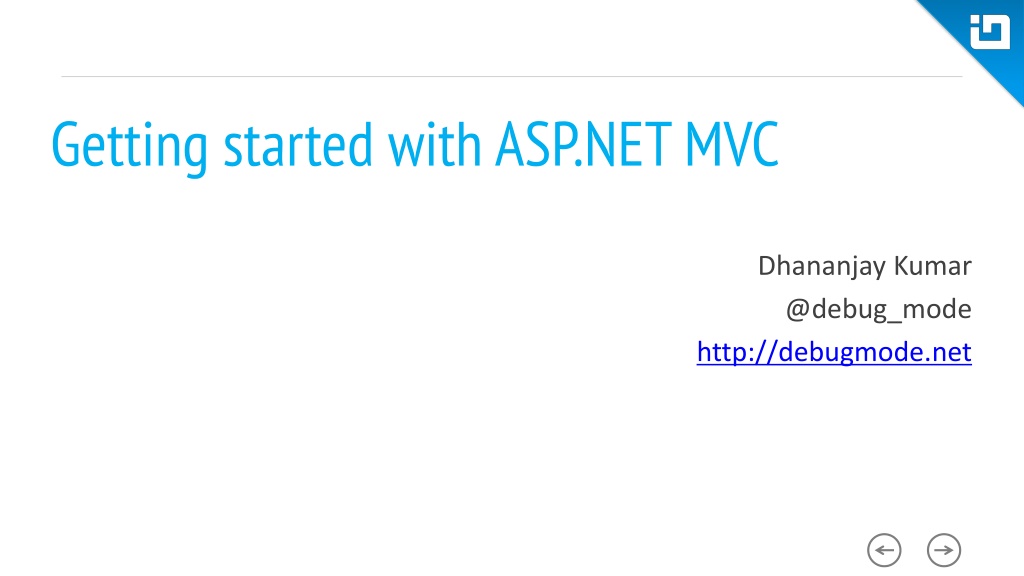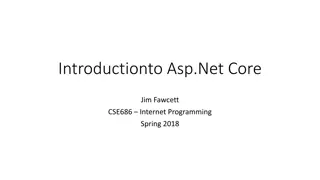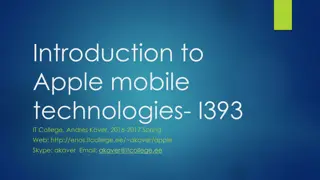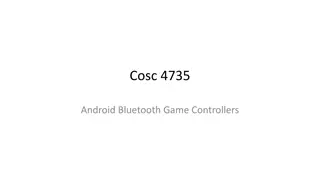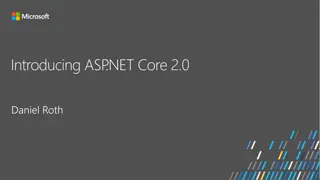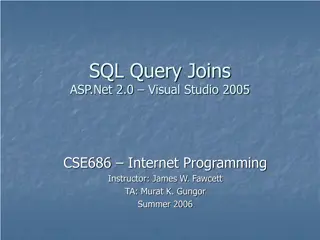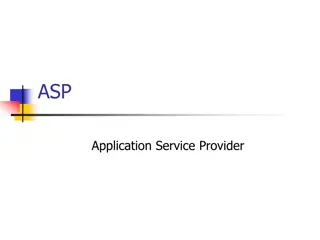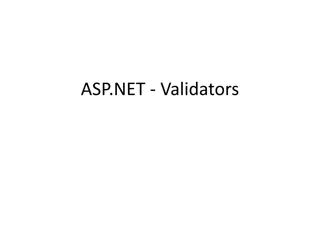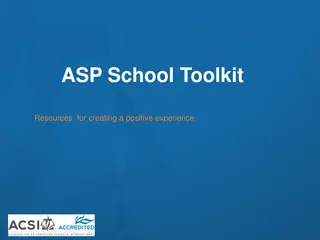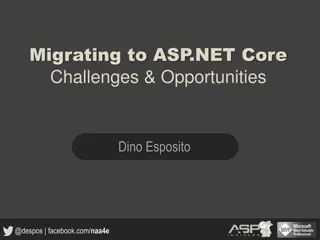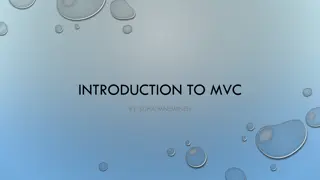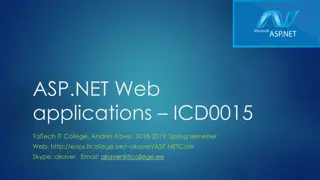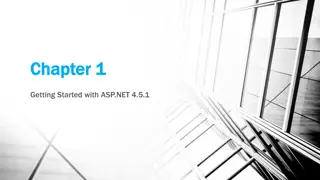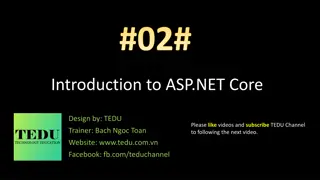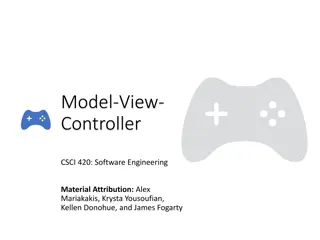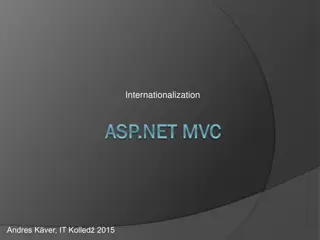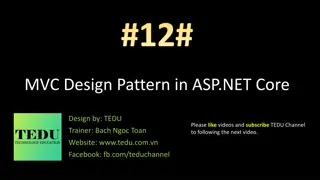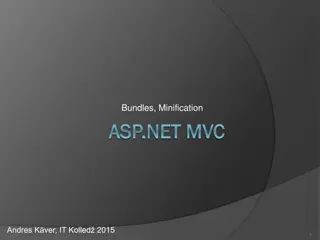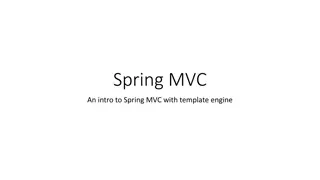Introduction to ASP.NET MVC: Understanding Controllers, Views, and Models
Explore the fundamentals of ASP.NET MVC with Dhananjay Kumar in this informative webinar. Delve into the concepts of Controllers, Views, and Models, learn about ViewBag, ViewData, and TempData, and discover the benefits of using client-side libraries like jQuery and Ignite UI. Gain insights into strongly-typed views, child actions, areas, and different approaches to building applications. Get ready to enhance your understanding of ASP.NET MVC and take your development skills to the next level.
Download Presentation

Please find below an Image/Link to download the presentation.
The content on the website is provided AS IS for your information and personal use only. It may not be sold, licensed, or shared on other websites without obtaining consent from the author. Download presentation by click this link. If you encounter any issues during the download, it is possible that the publisher has removed the file from their server.
E N D
Presentation Transcript
Getting started with ASP.NET MVC Dhananjay Kumar @debug_mode http://debugmode.net
Agenda Getting started with ASP.NET MVC Understanding Controllers Understanding Views Understanding Model ViewBag, ViewData, and TempData Strongly Typed and dynamic views Child Action and Partial Views Areas Database first approach Code first approach Using client side libraries like jQuery, Ignite UI
Give Away Tweet your experience about webinar using the hashtag #Infragistics or tag @infragistics to win cool goodies from us.
I am Dhananjay Kumar Developer Evangelist @infragistics 6 times Microsoft MVP @debug_mode debugmode@outlook.com http://debugmode.net
ASP.NET MVC Controller Model View
ASP.NET MVC Clean separation of concerns Enables or support Test Driven Development Easy integration with client side libraries like JavaScript, jQuery, and Ignite UI Developer has full control over the rendered HTML Due to stateless nature and URL routing, highly optimized for search engines Supports Authentication, authorization, configuration, compilation and deployment
Controller A Controller does all the actions in MVC. It handles user interactions or inputs. It passes user's data to a Model and selects a View to render on the UI. A Controller is a class It contains one or more methods called Actions An Action can return a simple string or a selected View to the UI Action takes all browser requests or user inputs It retrieves data from the Model It selects the View to be rendered on the UI
View Views are the components that display the application's user interface (UI) It renders user interface It contains markup to be rendered with the ViewEngine There are two kinds of ViewEngine in MVC- Razor and ASPX engine Controller may returns View View renders data from the Model returned by the Controller Controller can send data to View
Model Model is a class which represents the problem domain. Model implements logic for the application data. Model is a class It is accessible to both the view and the controller Views renders data from the model Controller can pass data from model to the view Model class contain the application logic Model is place of the ORM or Data Access frameworks
Model Business Logic ORM Application data logic Model
Passing Data dynamic object to pass data from controller to view ViewBag dictionary object to pass data from controller to view ViewData dictionary object to pass data from one controller/action to another controller/action TempData
TempData TempData is used to pass data from one HTTP request to next HTTP request. In other words, TempData is used to pass data from one controller to another controller or action to another action. TempData is property of BaseController class. TempData stores data in session object TempData is property of ControllerBase class To read data Typecasting and null checking is required. Type of TempData is TempDataDictionary. TempData works with HTTP redirection like HTTP 302/303 status code
Types of Views Views Dynamic Views Strongly Typed Views
Child Action Child Actions are the action methods which can be invoked within a view. Child Actions are the action methods which can be invoked within the view This is used to work with the data in the view, which are not related to the main action method In ASP.NET MVC any action can be used as a child action To use an action only as a child action and attribute it with the ChildActionOnly. It will make sure the action is not called by any user request and will only be used in the view.
Areas A MVC application can have any number of Areas Each Areas has its own controllers, models, and views. Physically Areas are put under separate folders. Areas are useful in managing big web applications
Summary Getting started with ASP.NET MVC Understanding Controllers Understanding Views Understanding Model ViewBag, ViewData, and TempData Strongly Typed and dynamic views Child Action and Partial Views Areas Database first approach Code first approach Using client side libraries like jQuery, Ignite UI
What Infragistics can offer you? We welcome all of you to take advantage of a FREE 30 Day Trial by downloading the product at: http://www.infragistics.com/products/ultimate/download Please reach out to us at Sales-India@infragistics.com for any follow up questions you may have. We welcome the opportunity to assist you.
